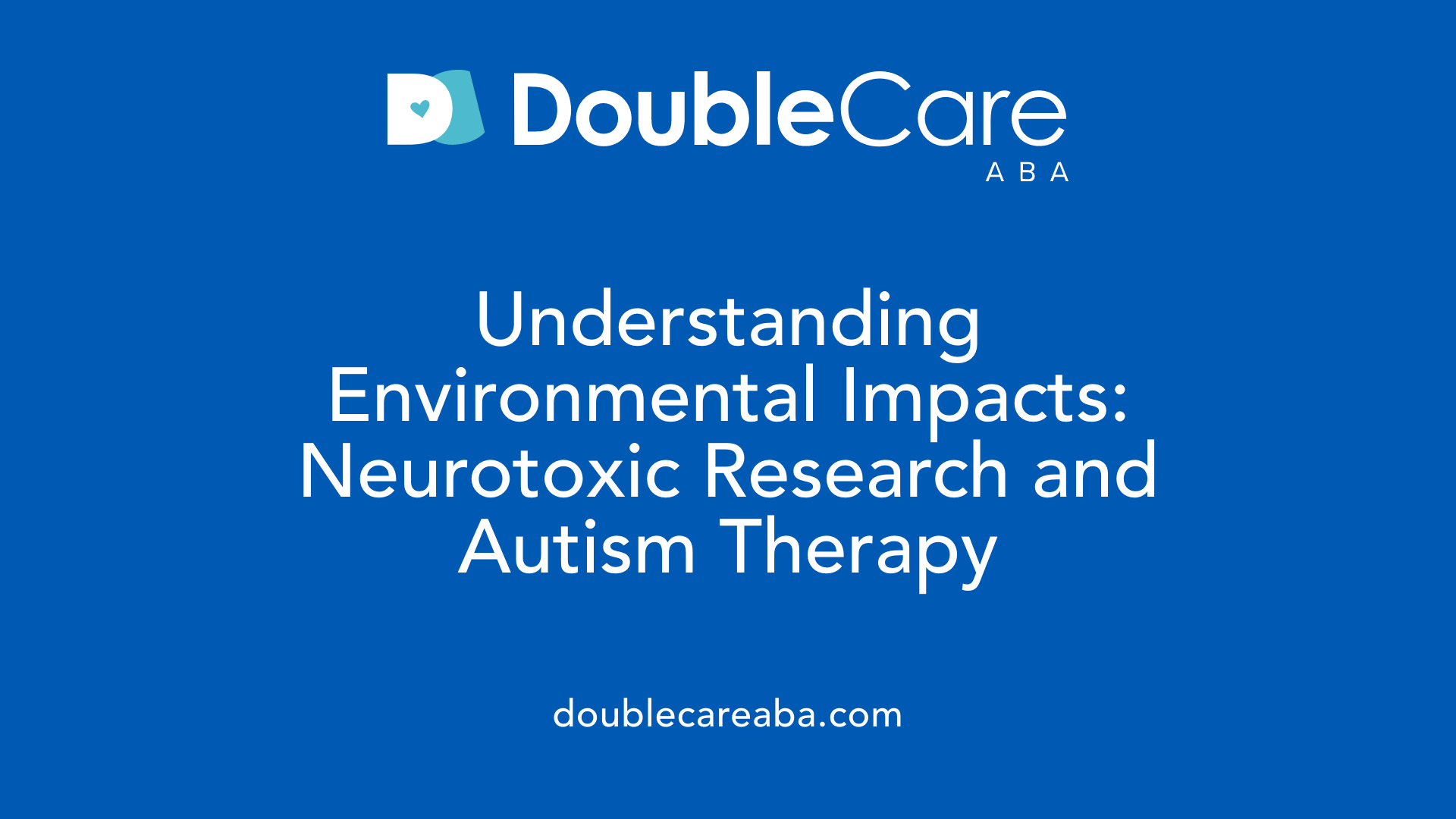Understanding the Debate on Fluoride and Autism
Public concern has grown over whether fluoride, a common additive in drinking water, might be linked to neurodevelopmental disorders such as autism. While fluoride is known for its dental health benefits, recent research has raised questions about its potential impact on children's brain development. This article delves into current scientific findings on fluoride exposure, examines autism therapies like Applied Behavior Analysis (ABA), and explores how these intersect in the broader context of child health and development.
The Science Behind Fluoride Exposure and Cognitive Development

What Are the Fluoride Exposure Levels Linked to IQ Changes?
Research shows that fluoride exposure at levels higher than 1.5 mg/L, particularly through drinking water, is linked to a decrease in children’s IQ scores. In regions where fluoride exceeds this level, such as parts of Canada, China, India, Iran, Pakistan, and Mexico, there have been reports of IQ declines of 2 to 5 points. In the U.S., around 1.9 million people receive water with naturally occurring fluoride at or above 1.5 mg/L, raising concerns about potential cognitive impacts.
How Does Fluoride Affect IQ?
A comprehensive analysis pooling data from over 8,000 children — mainly from China — revealed an average IQ reduction of about seven points associated with high fluoride in drinking water. A 2015 pilot study on lifetime fluoride exposure in Chinese children also supported the link between fluoride and reduced cognitive function. These findings suggest that fluoride exposure during critical developmental periods may interfere with brain function, leading to measurable changes in intelligence.
What Do Epidemiological and Animal Studies Show?
Epidemiological studies form the backbone of this research, assessing populations exposed to elevated fluoride levels and comparing cognitive outcomes. These studies consistently indicate an association between high fluoride intake and lowered IQ scores in children across various countries. Complementing human studies, animal research demonstrates that fluoride affects brain cells involved in learning, memory, and behavioral processes. This biological evidence helps explain the observed cognitive effects.
Does Fluoride Have Neurotoxic Potential?
The gathered evidence raises concern that fluoride could act as a neurotoxicant similar to lead or mercury, especially during children's brain development. Reviews of multiple studies confirm that fluoride exposure at high levels may adversely affect neurodevelopment. This potential neurotoxicity underlines the importance of further research to clarify fluoride's effects and to reassess safety standards for fluoride exposure.
Current Knowledge on Autism and Its Treatment Approaches

What is Applied Behavior Analysis (ABA) therapy?
ABA therapy is a scientific approach centered on understanding and modifying behavior, primarily used to support individuals with autism spectrum disorder. This method examines how environmental factors influence behavior and employs techniques such as positive reinforcement and meticulous data tracking. Its goal is to increase helpful skills like communication and social interaction while reducing harmful behaviors. ABA is widely accepted as an evidence-based best practice, particularly effective when started early and tailored to the individual's needs.
How is ABA therapy used in treating autism?
ABA therapy applies behavioral science principles to foster positive behavioral changes. Therapists break down complex skills into smaller, manageable steps and use positive reinforcement to encourage these behaviors. Continuous data collection and assessment help customize therapy to the individual’s progress and challenges. This process leads to improvements in intellectual functioning, language skills, social abilities, and daily living activities.
Who provides ABA therapy?
ABA therapy is delivered by trained professionals including Board Certified Behavior Analysts (BCBAs), Registered Behavior Technicians (RBTs), and Licensed Behavior Analysts. These experts design and implement personalized therapy plans and often work within multidisciplinary teams that may include speech and occupational therapists.
What qualifications do professionals need to offer ABA therapy?
Professionals offering ABA therapy typically hold certifications such as BCBA or BCaBA. These credentials require graduate-level education, supervised practical experience, and passing a certification exam administered by the Behavior Analysis Certification Board (BACB). Maintaining licensure and engaging in continuing education ensure that practitioners stay current with best practices and maintain competency.
Distinguishing Correlation from Autism Causation in Fluoride Research

Does fluoride cause autism?
Current research indicates that while high fluoride exposure is linked with lowered IQ and potential neurodevelopmental impacts in children, there is no conclusive scientific evidence establishing fluoride as a cause of autism spectrum disorder (ASD).
Link between fluoride and autism
Studies have predominantly examined the association of fluoride with cognitive function reductions, particularly IQ decreases, rather than directly assessing autism incidence. Research from various countries shows that elevated fluoride in drinking water correlates with neurodevelopmental concerns but stops short of demonstrating autism causality.
Scientific consensus on causality
The scientific community acknowledges fluoride’s possible neurotoxic effects comparable to those of lead or mercury, primarily affecting learning, memory, and behavior areas of the brain. However, there is no accepted consensus that fluoride exposure induces ASD. Instead, fluoride research emphasizes cognitive development rather than autism diagnosis.
Neurodevelopmental concerns vs. autism diagnosis
A systematic review and meta-analysis involving thousands of children highlighted fluoride’s potential to reduce IQ scores by several points but did not find a direct association with autism. Neurodevelopmental impacts such as IQ loss differ fundamentally from autism spectrum disorders, which involve complex behavioral and social communication criteria.
Further research is crucial to clarify fluoride’s full impact on neurodevelopment and to explore any possible links with autism more definitively.
Public Health Considerations and Fluoride Regulation

What are the concerns about fluoride levels in public water?
Approximately 1.9 million people in the U.S. consume drinking water with naturally occurring fluoride concentrations at or above 1.5 mg/L. This level exceeds the commonly recommended safe threshold, raising concerns about potential neurodevelopmental effects in children.
Fluoride levels in U.S. water supplies
In some regions, naturally high fluoride levels have been documented in water sources. While fluoride is added at controlled levels to many public water systems to prevent tooth decay, excessive exposure from multiple sources could lead to concentrations surpassing safety guidelines.
Safe exposure guidelines
Regulatory agencies aim to maintain fluoride concentrations at levels that maximize dental health benefits while minimizing risks. Currently, 1.5 mg/L is generally recognized as the upper limit for safe fluoride concentration in drinking water. Exposing populations to levels above this may increase the risk of cognitive impacts noted in epidemiological studies.
Importance of further research
Emerging evidence suggests fluoride exposure, especially exceeding 1.5 mg/L, might adversely affect children's IQ and cognitive development. Given these findings, ongoing research is essential to better understand long-term neurodevelopmental effects and to guide effective public health policies. Such studies will help ensure fluoride regulations protect not only dental health but also broader neurological wellbeing.
Integrating Neurodevelopmental Insights with Autism Treatment Planning

How Does Neurotoxic Research Influence Therapy Approaches?
Recent research highlighting the neurotoxic effects of substances like fluoride underscores the importance of understanding environmental factors in neurodevelopmental disorders. These insights encourage therapists and clinicians to consider potential environmental contributors when tailoring autism therapy. Recognizing that certain exposures may affect brain regions involved in learning and behavior can inform more nuanced treatment strategies.
Why Is Early Intervention Crucial in Autism Treatment?
Early intervention remains paramount, as young brains exhibit greater plasticity. Given research linking high levels of fluoride exposure to reduced IQ and cognitive delays, initiating therapy early can help mitigate impacts from various neurodevelopmental challenges. Timely support enhances the effectiveness of therapeutic techniques and fosters better developmental outcomes.
What Role Does ABA Play Amid Neurodevelopmental Concerns?
Applied Behavior Analysis (ABA) continues to be a leading approach in autism therapy, emphasizing behavior modification based on individual learning patterns. Integrating findings on neurotoxicity allows practitioners to customize ABA methods that accommodate possible environmental influences on cognitive function. This adaptability ensures therapy remains relevant and responsive to each child’s unique needs.
How Is Scientific Evaluation Ongoing?
Ongoing scientific evaluation is critical in refining treatment models as new findings emerge. Studies investigating fluoride’s impact on neurodevelopment highlight the necessity for continuous research into environmental effects on autism. Therapists and researchers collaborate to update and improve intervention protocols, ensuring they reflect the latest evidence on neurotoxic risks and developmental health.
These multidimensional insights promote a comprehensive approach to autism treatment that is scientifically informed and sensitive to environmental factors affecting neurodevelopment.
Balancing Fluoride Exposure and Autism Awareness
Although emerging research points to potential cognitive effects from high fluoride exposure, no direct causal link to autism has been established. Autism remains a complex neurodevelopmental disorder best addressed through evidence-based therapies such as ABA, which effectively support behavioral and cognitive development. As scientific understanding of fluoride’s neurodevelopmental impact evolves, it is crucial for public health policies and autism treatment strategies to remain informed by rigorous research, ensuring both safe environmental exposures and optimized care for those with autism spectrum disorder.
References
- Government report links excessive fluoride in water to ...
- Impact of fluoride on neurological development in children
- Applied Behavior Analysis (ABA)
- Applied Behavior Analysis (ABA)
- The Top 10 Reasons Children With Autism Deserve ABA
- 6 Benefits of ABA Therapy for Children with Autism
- Applied Behavior Analysis (ABA)
- Applied Behavior Analysis (ABA)














